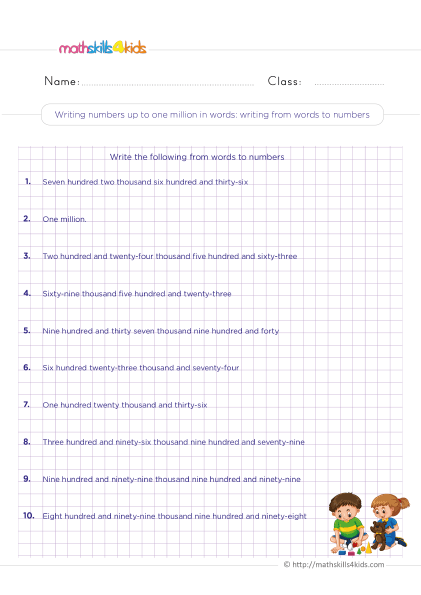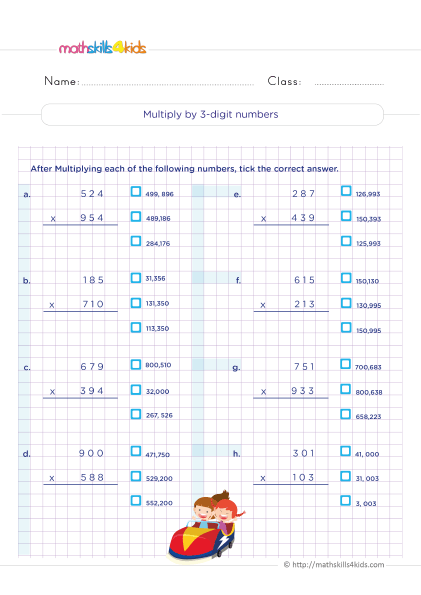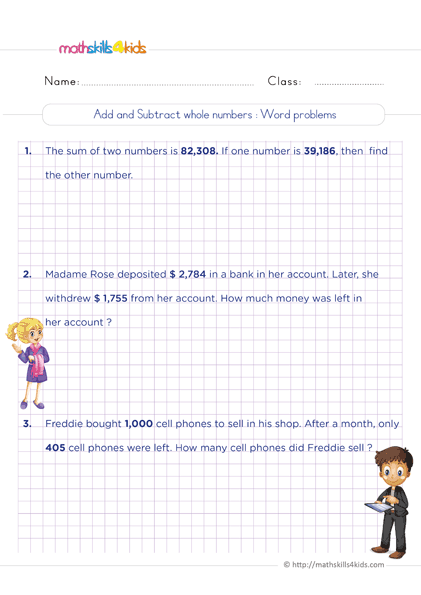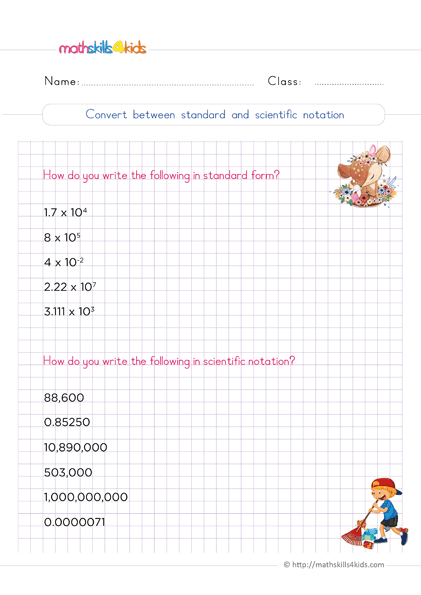6th-Grade Math Whole Numbers Worksheets with Solutions

Are you looking for some 6th-grade math whole numbers worksheets with solutions for your students? If so, you've come to the right place. In this post, you’ll find comprehensive questions in whole numbers containing 10 multiple-choice questions (MCQs), 10 true or false questions, and 10 original word problems on whole numbers.
These questions are designed to help your students understand whole numbers' basic concepts and properties, such as place value, ordering, comparing, rounding, addition, subtraction, multiplication, and division.
You can use our exercises as a review, a quiz, a homework assignment, or a class activity. Our teaching resources also have an answer key and explanations for easy grading.
Further, we have designed worksheets available in PDF format, and you can download them for free by clicking on the related links. I hope you and your students find it valuable and enjoyable.
-
Grade 6 Maths Whole Numbers Multiple Choice Questions (MCQs)
After going through the questions on Grade 6 Maths Whole Numbers Multiple Choice Questions (MCQs), you can check all the answers below.
-
Which of the following is the standard form of 7 x 105 + 4 x 103 + 9 x 101?
- 70409
- 74090
- 700409
- 704090
2. Which of the following is the word form of 8,765,432?
- Eight million seven hundred sixty-five thousand four hundred thirty-two
- Eight million seven hundred sixty-four thousand five hundred thirty-two
- Eight million seven hundred fifty-six thousand four hundred thirty-two
- Eight million seven hundred fifty-four thousand six hundred thirty-two
3. Which of the following is the correct way to compare the numbers 456 and 465 using a symbol?
- 456 < 465
- 456 > 465
- 456 = 465
- None of the above
4. Which of the following is the closest estimate of the sum of 789 and 654 by rounding each number to the nearest hundred?
- 1000
- 1200
- 1400
- 1500
5. Which of the following is the difference of 9876 and 5432?
- 4444
- 4344
- 4434
- None of the above
-
6. Which of the following is the product of 12 x 34?
- 408
- 418
- 428
- None of the above
7. Which of the following is the quotient of 567 ÷ 9?
- 63
- 64
- 65
- None of the above
8. Which property of whole numbers is illustrated by the equation (3 + 4) + 5 = 3 + (4 + 5)?
- Commutative property of addition
- Associative property of addition
- Distributive property of multiplication over addition
- Identity property of addition
9. Which property of whole numbers is illustrated by the equation (2 x 3) x 4 = (3 x 2) x 4?
- Commutative property of multiplication
- Associative property of multiplication
- Distributive property of multiplication over addition
- Identity property of multiplication
10. Which property of whole numbers is illustrated by the equation (5 x 6) + (5 x 4) = (5 x (6 +4))?
- Commutative property of multiplication
- Associative property of multiplication
- Distributive property of multiplication over addition
- Identity property of multiplication
-
-

Click the links below to download Grade 6 Maths Whole Numbers worksheets:
Grade 6 Maths Whole Numbers Multiple Choice Questions (MCQs) answers
-
1. C
2. A
3. A -
4. C
5. A
6. A -
7. A
8. B
9. A
10. C
Class 6 Maths Whole Numbers True (T) or False (F) Questions
Complete the questions on Class 6 Maths Whole Numbers True (T) or False (F), then see all the answers here.
-
- The smallest whole number is zero. (T/F)
- The successor of a whole number is one more than that number. (T/F)
- The predecessor of a whole number is one less than that number. (T/F)
- Every natural number is a whole number. (T/F)
- Every whole number is a natural number. (T/F)
- The sum of two whole numbers is always a whole number. (T/F)
- The difference of two whole numbers is always a whole number. (T/F)
- The product of two whole numbers is always a whole number. (T/F)
- The quotient of two whole numbers is always a whole number. (T/F)
- Zero has no reciprocal. (T/F)
Class 6 Maths Whole Numbers True (T) or False (F)
Here are the answers to Class 6 Maths Whole Numbers True (T) or False (F):
-
- True
- True
- True
-
- True
- False
- True
-
- False
- True
- False
- True
Class 6 Math whole numbers word problems with answers
In this section, you will find comprehensive Class 6 Math whole numbers word problems with answers for testing your students’ or children’s skills in addition, subtraction, multiplication, division, and comparison of whole numbers.
Are you ready to take on the challenge, let's get started!
Problem 1:
A school has 12 classes with 40 students each. How many students are there in the school?
Solution 1:
To find the total number of students in the school, we need to multiply the number of classes by the number of students in each class. This is a multiplication problem.
12 x 40 = 480
There are 480 students in the school.
-
Problem 2:
A book has 250 pages. Ria reads 15 pages every day. How many days will it take her to finish the book?
Solution 2:
To find the number of days it will take Ria to finish the book, we need to divide the total number of pages by the number of pages she reads every day. This is a division problem.
250 ÷ 15 = 16 r 10
This means that Ria can read 16 full days and still have 10 pages left on the last day. So, she will need one more day to finish the book.
It will take Ria 17 days to finish the book.
Problem 3:
A box contains 36 pencils. How many boxes are needed to pack 720 pencils?
Solution 3:
To find the number of boxes needed to pack 720 pencils, we need to divide the total number of pencils by the number of pencils in each box. This is a division problem.
720 ÷ 36 = 20
We need 20 boxes to pack 720 pencils.
Problem 4:
A factory produces 500 toys every hour. How many toys will it produce in a day?
Solution 4:
To find the number of toys produced in a day, we need to multiply the number of toys produced every hour by the number of hours in a day. This is a multiplication problem.
500 x 24 = 12000
The factory will produce 12000 toys in a day.
Problem 5:
A pizza is cut into 8 equal slices. Raj eats 3 slices, and Rahul eats 2 slices. How many slices are left?
Solution 5:
To find the number of slices left, we need to subtract the number of slices eaten by Raj and Rahul from the total number of slices. This is a subtraction problem.
8 - (3 + 2) = 8 - 5 = 3
There are 3 slices left.
-
Problem 6:
A train has 18 coaches with 72 seats each. How many passengers can travel in the train?
Solution 6:
To find the number of passengers that can travel in the train, we need to multiply the number of coaches by the number of seats in each coach. This is a multiplication problem.
18 x 72 = 1296
The train can carry 1296 passengers.
Problem 7:
A school has 345 students in Class 6A and 378 students in Class 6B. How many students are there in total in Class 6?
Solution 7:
To find the total number of students in Class 6, we need to add the number of students in Class 6A and Class 6B. This is an addition word problem.
345 + 378 = 723
Therefore, there are 723 students in total in Class 6.
Problem 8:
A farmer harvested 5,678 kg of wheat from his field. He sold 2,345 kg of wheat to a mill and gave away 789 kg of wheat to his neighbors. How much wheat did he have left?
Solution 8:
To find the amount of wheat left, we need to subtract the amount of wheat sold and given away from the amount of wheat harvested. This is a subtraction problem.
5,678 – 2,345 - 789 = 2,544
Therefore, he had 2544 kg of wheat left.
-
Problem 9:
A factory produces 456 boxes of biscuits every day. Each box contains 24 packets of biscuits. How many packets of biscuits do the factory produce in a day?
Solution 9:
To find the number of packets of biscuits produced in a day, we need to multiply the number of boxes by the number of packets in each box. This is a multiplication problem.
456 x 24 = 10,944
Therefore, the factory produces 10944 packets of biscuits in a day.
Problem 10:
A school library has 12,336 books. The librarian wants to arrange them equally on 48 shelves. How many books will there be on each shelf?
Solution 10:
To find the number of books on each shelf, we need to divide the total number of books by the number of shelves. This is a division problem.
12,336 ÷ 48 = 257
Therefore, there are 257 books on each shelf.





